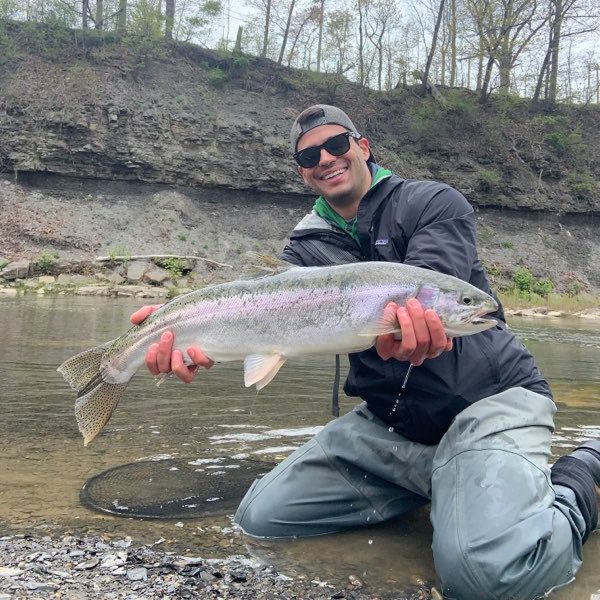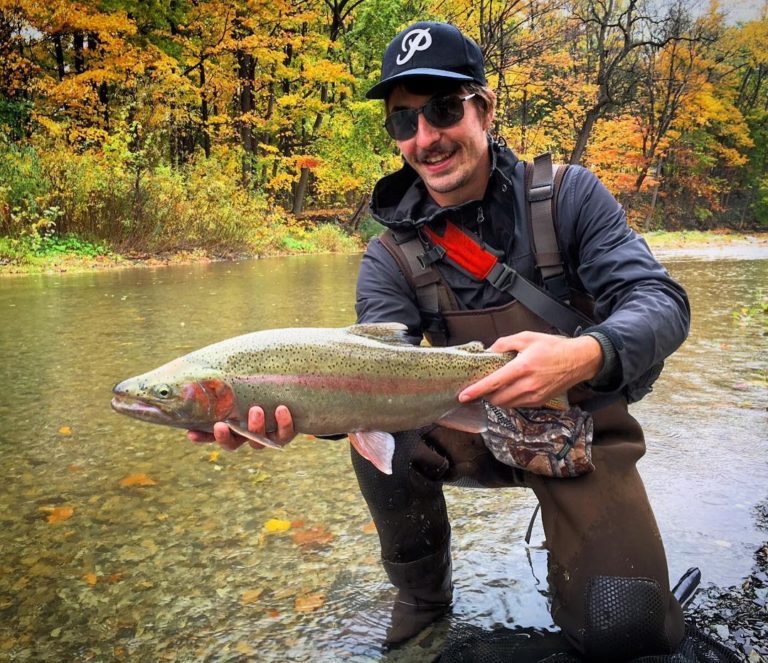The Steelhead

The steelhead (Oncorhynchus mykiss) is a cold-water sport fish found in the Great Lakes and their tributaries. Steelhead typically range between 20 and 30 inches in length and can vary quite a bit in appearance. When residing in Lake Erie or Ontario, steelhead have a silver body, a dull olive/gray back, and small black spots distributed across their body, especially above their lateral line. When steelhead run up creeks and rivers in the fall, their coloration changes quite a bit. Spawning steelhead in creeks and rivers usually have dark olive backs, a light pink to sometimes deep red stripe running from gill plate to anal fin, and small black spots that are quite pronounced and numerous, especially above their lateral line.
Steelhead are one of many anadromous salmonids found in western New York and are a hugely popular sportfish. Steelhead can be distinguished from Chinook and Coho salmon by the color of their mouth, which is always white on the inside with no black. Unlike salmon, steelhead are very common in Lake Erie as well as Lake Ontario.
Rainbow trout and steelhead are the same species of fish (Oncorhynchus mykiss). However, the term “steelhead” is used to refer to the rainbow trout found in lakes Erie and Ontario that are anadromous, meaning that they swim up creeks and rivers from the Great Lakes to spawn. In western New York, there are also rainbow trout that reside permanently in creeks and streams and do not venture into lakes Erie or Ontario. These rainbow trout are usually referred to as just “rainbow trout”, or more specifically, as “inland rainbow trout.” There is a separate article for inland rainbow trout.
Habitat
Steelhead are anadromous fish, meaning they reside in a large body of water before swimming up creeks and rivers to spawn. Steelhead will live in the deep water of Lake Erie or Ontario during the early stage of their lives and during the summer between spawning runs. Once they reach sexual maturity, steelhead swim up creeks and rivers to spawn during fall, winter, and spring. During the spawn, steelhead typically reside in deep pools and runs in creeks and rivers. Steelhead also like the well oxygenated water beneath waterfalls. Unlike salmon, steelhead do not face programmed post-spawn death and can return to the lake after spawning. It is therefore possible for steelhead to make multiple spawning runs throughout their lifetime.
Both Lake Erie and Ontario hold good populations of steelhead. Lake Erie and Ontario maintain the cold water temperatures needed for steelhead survival year round. While residing in the Great Lakes, steelhead cruise the water column, typically at depths below 80 feed, feeding on baitfish.
Food
When residing in Lake Erie or Ontario, steelhead feed on baitfish. The plentiful supply of baitfish in Lake Erie and Ontario allows steelhead to reach great sizes. Once they enter creeks and rivers, steelhead will feed on baitfish, aquatic insects, and the eggs of spawning fish. Steelhead will actively feed during their run unlike salmon.
Where to Catch Steelhead
Both Lake Erie and Lake Ontario maintain good populations of steelhead, and steelhead are stocked extensively in Lake Erie and Ontario and their tributaries. Therefore, the most popular place to target steelhead salmon are the Erie and Ontario tributaries in Niagara, Orleans, Erie, Chautauqua, and Cattaraugus Counties.
In the summer, steelhead reside in Lake Ontario or Erie, and cannot be caught in tributaries. The best way to target steelhead in the summer is by trolling in deep water with a boat. The only exception to this is rare occasions when upwelling occurs near the Lake Ontario shores. When upwelling occurs and colder water is pushed up from the deep, salmon and trout can become confused and enter the mouths of Ontario tributaries. These events can occur in July or August and are very short lived.
The only time to target steelhead without a boat is during the run. The steelhead run usually begins in early October and lasts through late April. During the run, steelhead can be caught in most Lake Erie and Ontario tributaries. The most popular Lake Erie tributaries are Buffalo Creek, Cattaraugus Creek, and 18 Mile Creek. The most popular Lake Ontario tributaries are 18 Mile Creek and Oak Orchard River. When fishing these streams, you will not be alone. During the fall, anglers seem to outnumber the fish!

How to Catch Steelhead
Fly-fishing is one popular method for targeting steelhead in creeks and rivers. Productive baits for steelhead include egg patterns, nymphs, and streamers. It is usually best to fish egg patterns and nymphs under an indicator with split shot weight added about 1 foot from the hook. Enough split shot should be added so that your weight reaches and drags on the bottom of the stream.
Swinging streamers is another good option, especially during the fall when creek temperatures are still relatively warm or during the spring when water temperatures are on the rise. Any streamer will work well for steelhead provided it is presented properly. Unlike salmon, steelhead will readily feed throughout the run and will attack your bait if presented properly.
Spin fishing is another way to target steelhead during the run. Productive baits for the spin fisherman include egg sacs, trout beads, spinners, and jigs. Fishing egg sacs under a float is especially popular amongst spin fisherman on Great Lakes tributaries. Jigs tipped with wax worms or minnows also work well.
There is some good information regarding steelhead fishing in western New York on the NYS DEC website including public fishing access maps that can be found here: http://www.dec.ny.gov/outdoor/32426.html The NYS DEC website is a great resource and should be the first place you look for information on fishing western New York.
